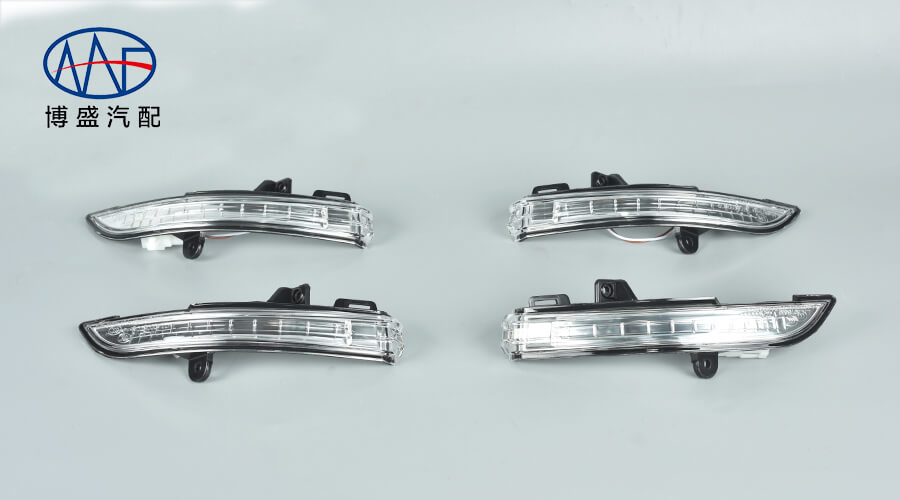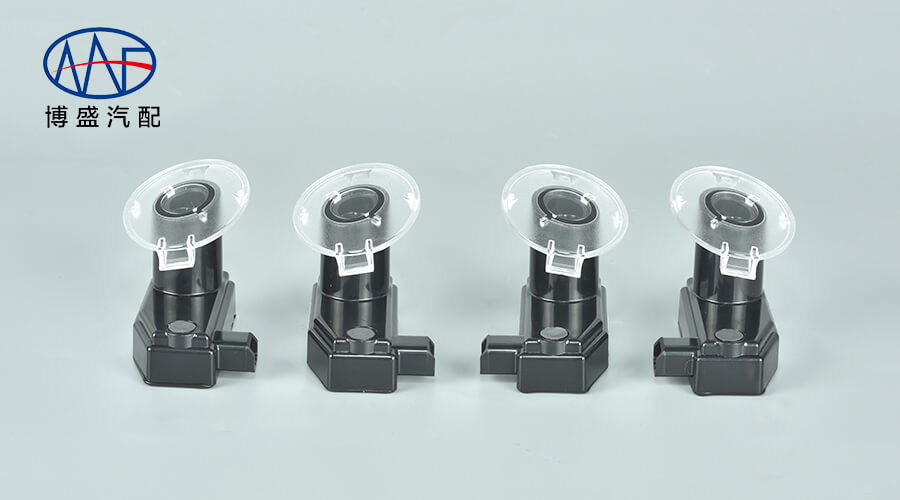Automobile lamp
2018-11-02 15:55:00 Copyfrom:本站 view:3532
Floodlight
1. Headlamp: The main purpose of headlamp is to illuminate the road and objects in front of the car to ensure the safety of driving. Far light and near light can also be used as overtaking signals at night. The headlamp is installed on both sides of the head of the car. Each car has two or four headlamps. The power of the bulb is 45 ~ 60W for the high light lamp and 25 ~ 55W for the low light lamp.
2. Fog lamp: Fog lamp is installed near the headlamp or slightly lower than the headlamp. It is used as road lighting and signal for oncoming vehicles when visibility is low, such as fog, snow, heavy rain or diffuse dust. Most of the lights are yellow, because the yellow light wave is long and has good fog permeability. The lamp power is generally 35W.
3. Reversing light: The reversing light is installed at the rear of the car to illuminate the road behind the car and inform the vehicle and pedestrians that the vehicle is reversing or preparing to reverse. It has the function of light signal device. The light is white and the power is 28W.
4. License Lamp: The license lamp is mounted on the top of the rear license plate of the vehicle, and its purpose is to illuminate the rear license plate of the vehicle. The requirement is to see the number on the license plate at 20M behind the car at night. The light is white and the power is usually 8-10W.
5. Top lights: lamps installed in the cab or on the top of the car for lighting in the cab. The top lamp is white, and the lampshade is mostly made of transparent plastic. The power of the bulb is usually 5 ~ 8W.
6. Instrument lamp: It is the instrument lighting tool, often connected with the instrument panel. The light is white, and the power of the bulb is usually 2 to 8 W.
7. Step lamp: It is used to illuminate the door and step, and to facilitate passengers to get on and off. The light is white and the power of the bulb is usually 5-8W.
8. Luggage light: It is a lamp in the luggage of a car. The light is white and the power is 5-8w.
9. Tool lamp: It is used in repairing automobiles. It is equipped with working lamp sockets and movable lamps with wires. The light is white, and the power of the bulb is usually between 8 and 20 W.
Lighting lamps should provide good lighting and minimize glare. For headlamp, in order to meet the above two requirements, two working conditions of far light and near light are adopted. Far-light is a long-distance illumination beam used when there is no car coming or not following other cars in the front. It is produced by the main filament located at the focus of the reflector and with high power. The direction of the beam is approximately horizontal. It is usually stipulated that the maximum luminous intensity of a single lamp should be no less than 20,000 candelas. In order to ensure the safety of driving, the distance of illumination (the distance of finding and identifying obstacles) of far light should be greater than the braking distance of timely parking. Since the required far-light intensity is proportional to the fourth power of speed, speed limits are applied in most countries. In addition, in order to avoid the driver's short-term loss of recognition ability due to the wide variation of light and shade when the far and near light conditions change, it is stipulated that the maximum luminous intensity of the far light of all headlamps should not exceed 225,000 Candela. Near-light is a short-range illumination beam used in Rendezvous or following other vehicles. It is produced by a sub-filament with smaller power. Because of the deviation from the focus and axis of the reflector, the beam is projected downward. In order to limit the beam above the horizontal direction, a metal light shield is usually installed under the sub-filament, so that a light shape with sharp change of light and shade is formed on the vertical screen. At the intersection, the driver's eyes are located in the dark area of near-light shape, thus restraining the glare to the greatest extent.
Signal lamp
Position light. Installed in the front and rear of the car, indicating the existence of the driving car and the body width.
Brake lights. Installed in the rear, indicating that the driving car decelerates or stops.
(3) Turning signal. Installed in the front, rear and side, indicating the steering of the car.
4 rear fog lamps. Installed in the rear, to improve the fog, snow and other bad weather conditions, the rear of the car visibility.
Display lights. Installed in the front and rear, marking the car's outline.
Parking lights. Installed on the side, indicating the presence of parked vehicles.
Signal lights enable other road users located at a certain distance to clearly identify light signals. The parameters related to the lamp include luminous intensity, luminous area, beam diffusion angle and light color. In order to recognize light signals easily at night with dark background, the luminous intensity of signal lights used only at night, such as position lights, outline lights and parking lights, is usually only between a few candelas and dozens of candelas. For the signal lights used day and night, such as steering lights, brake lights, etc., the required light intensity during the day is usually as high as hundreds of Candelas. In order not to produce glare when this kind of signal lamp works at night, in addition to limiting the maximum luminous intensity, some of them also use day and night working conditions. For most of the automobile signal lights which are sensed at close range, the matching between the luminous area and the prescribed luminous intensity must also be considered to prevent the excessive brightness from causing blindness. The beam diffusion angle of most signal lamps (the angle between 10% maximum intensity directions) is not less than 20 degrees in vertical direction and 40 degrees in horizontal direction.
1. Headlamp: The main purpose of headlamp is to illuminate the road and objects in front of the car to ensure the safety of driving. Far light and near light can also be used as overtaking signals at night. The headlamp is installed on both sides of the head of the car. Each car has two or four headlamps. The power of the bulb is 45 ~ 60W for the high light lamp and 25 ~ 55W for the low light lamp.
2. Fog lamp: Fog lamp is installed near the headlamp or slightly lower than the headlamp. It is used as road lighting and signal for oncoming vehicles when visibility is low, such as fog, snow, heavy rain or diffuse dust. Most of the lights are yellow, because the yellow light wave is long and has good fog permeability. The lamp power is generally 35W.
3. Reversing light: The reversing light is installed at the rear of the car to illuminate the road behind the car and inform the vehicle and pedestrians that the vehicle is reversing or preparing to reverse. It has the function of light signal device. The light is white and the power is 28W.
4. License Lamp: The license lamp is mounted on the top of the rear license plate of the vehicle, and its purpose is to illuminate the rear license plate of the vehicle. The requirement is to see the number on the license plate at 20M behind the car at night. The light is white and the power is usually 8-10W.
5. Top lights: lamps installed in the cab or on the top of the car for lighting in the cab. The top lamp is white, and the lampshade is mostly made of transparent plastic. The power of the bulb is usually 5 ~ 8W.
6. Instrument lamp: It is the instrument lighting tool, often connected with the instrument panel. The light is white, and the power of the bulb is usually 2 to 8 W.
7. Step lamp: It is used to illuminate the door and step, and to facilitate passengers to get on and off. The light is white and the power of the bulb is usually 5-8W.
8. Luggage light: It is a lamp in the luggage of a car. The light is white and the power is 5-8w.
9. Tool lamp: It is used in repairing automobiles. It is equipped with working lamp sockets and movable lamps with wires. The light is white, and the power of the bulb is usually between 8 and 20 W.
Lighting lamps should provide good lighting and minimize glare. For headlamp, in order to meet the above two requirements, two working conditions of far light and near light are adopted. Far-light is a long-distance illumination beam used when there is no car coming or not following other cars in the front. It is produced by the main filament located at the focus of the reflector and with high power. The direction of the beam is approximately horizontal. It is usually stipulated that the maximum luminous intensity of a single lamp should be no less than 20,000 candelas. In order to ensure the safety of driving, the distance of illumination (the distance of finding and identifying obstacles) of far light should be greater than the braking distance of timely parking. Since the required far-light intensity is proportional to the fourth power of speed, speed limits are applied in most countries. In addition, in order to avoid the driver's short-term loss of recognition ability due to the wide variation of light and shade when the far and near light conditions change, it is stipulated that the maximum luminous intensity of the far light of all headlamps should not exceed 225,000 Candela. Near-light is a short-range illumination beam used in Rendezvous or following other vehicles. It is produced by a sub-filament with smaller power. Because of the deviation from the focus and axis of the reflector, the beam is projected downward. In order to limit the beam above the horizontal direction, a metal light shield is usually installed under the sub-filament, so that a light shape with sharp change of light and shade is formed on the vertical screen. At the intersection, the driver's eyes are located in the dark area of near-light shape, thus restraining the glare to the greatest extent.
Signal lamp
Position light. Installed in the front and rear of the car, indicating the existence of the driving car and the body width.
Brake lights. Installed in the rear, indicating that the driving car decelerates or stops.
(3) Turning signal. Installed in the front, rear and side, indicating the steering of the car.
4 rear fog lamps. Installed in the rear, to improve the fog, snow and other bad weather conditions, the rear of the car visibility.
Display lights. Installed in the front and rear, marking the car's outline.
Parking lights. Installed on the side, indicating the presence of parked vehicles.
Signal lights enable other road users located at a certain distance to clearly identify light signals. The parameters related to the lamp include luminous intensity, luminous area, beam diffusion angle and light color. In order to recognize light signals easily at night with dark background, the luminous intensity of signal lights used only at night, such as position lights, outline lights and parking lights, is usually only between a few candelas and dozens of candelas. For the signal lights used day and night, such as steering lights, brake lights, etc., the required light intensity during the day is usually as high as hundreds of Candelas. In order not to produce glare when this kind of signal lamp works at night, in addition to limiting the maximum luminous intensity, some of them also use day and night working conditions. For most of the automobile signal lights which are sensed at close range, the matching between the luminous area and the prescribed luminous intensity must also be considered to prevent the excessive brightness from causing blindness. The beam diffusion angle of most signal lamps (the angle between 10% maximum intensity directions) is not less than 20 degrees in vertical direction and 40 degrees in horizontal direction.
24 Hours Service Hotline
0086-577-62338818
 WeChat qr code
WeChat qr code
 Website qr code
Website qr code
find us
Address :No. 1 Xixi Industrial Xinxia Road, Hongqiao Town, Yueqing City, Zhejiang Province
Tel : 086-577-62338818/62337600
Mail : boshengqipei@wz-bs.com
Whatsapp : +86 13656537666
Copyright © 2018 Wenzhou bosheng automobile parts co., LTD. All rights reserved. 浙ICP备18043895号-1 


浙公网安备 33038202003554号






